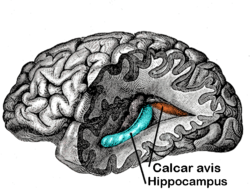Calcar avis
| Calcar avis (calcarine spur) | |
|---|---|
 Posterior and inferior cornua of left lateral ventricle exposed from the side. | |
 Coronal section through posterior cornua of lateral ventricle. | |
| Identifiers | |
| NeuroNames | 210 |
| TA98 | A14.1.09.285 |
| TA2 | 5660 |
| FMA | 83707 |
| Anatomical terms of neuroanatomy | |
The calcar avis, previously known as the hippocampus minor,
It is sometimes visible on
Name
The ridge was originally described by anatomists as the calcar avis, while the ridge running along the floor of the
The renaming of the hippocampus as hippocampus major, and the calcar avis as hippocampus minor, has been attributed to Félix Vicq-d'Azyr systematising nomenclature of parts of the brain in 1786. While "hippocampus minor" was used interchangeably with "calcar avis" for much of the 19th century, for a few years after 1861 the former name was subjected to publicity and ridicule when the hippocampus minor became the centre of a dispute over human evolution between Thomas Henry Huxley and Richard Owen, satirised as the Great Hippocampus Question. The term hippocampus minor fell from use in anatomy textbooks, and was officially removed in the Nomina Anatomica of 1895, but still featured in the Encyclopædia Britannica of 1926, and appeared in general dictionaries as late as 1957.[6]
Additional images
-
Human brain right dissected lateral view
References
![]() This article incorporates text in the public domain from page 831 of the 20th edition of Gray's Anatomy (1918)
This article incorporates text in the public domain from page 831 of the 20th edition of Gray's Anatomy (1918)
- S2CID 19663125.
- S2CID 19663125.
- PMID 4011898.
- S2CID 21436034.
- ^ Duvernoy 2005
- ^ Gross 1993, p. 405
- Duvernoy, HM (2005). "Introduction". The Human Hippocampus (3rd ed.). Berlin: Springer-Verlag. p. 1. ISBN 3-540-23191-9.
- Gross, Charles G. (1993). "Hippocampus Minor and Man's Place in Nature: A Case Study in the Social Construction of Neuroanatomy". S2CID 15172043.

